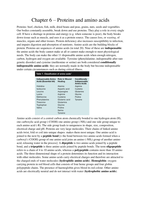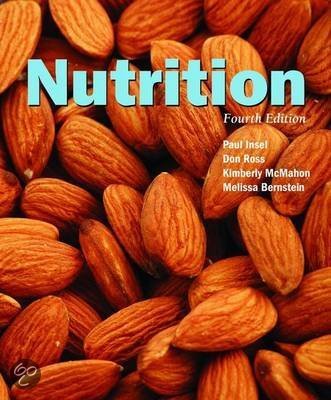Chapter 6 – Proteins and amino acids
Proteins: beef, chicken, fish, milk, dried beans and peas, grains, nuts, seeds and vegetables.
Our bodies constantly assemble, break down and use proteins. They play a role in every single
cell. If have a shortage in proteins and energy (e.g. when someone is poor), the body breaks
down tissue such as muscle, and uses it as a protein source. The causes loss, or wasting, of
muscles, organs and other tissues. Protein deficiency also increases susceptibility to infection,
and impairs digestion and absorption of nutrients. Amino acids are the building blocks of
protein. Proteins are sequences of amino acids (in total 20). Nine of these are indispensable:
the amino acids the body cannot make at all or cannot make enough to meet physiological
needs. The body can make the other 11 dispensable amino acids when enough nitrogen,
carbon, hydrogen and oxygen are available. Tyrosine (phenylalanine; indispensable after rare
genetic disorder) and cysteine (methionine or serine) are both considered conditionally
indispensable amino acids: they are normally made in the body but become indispensable
under certain circumstances such as during critical illness.
Amino acids consist of a central carbon atom chemically bonded to one hydrogen atom (H),
one carboxylic acid group (-COOH) one amino group (-NH2) and one side group unique to
each amino acid (-R). The side group leads to uniqueness in shape, size, composition,
electrical charge and pH. Proteins are very large molecules. Their chains of linked amino
acids twist, fold or coil into unique shapes: makes them most unique. One amino acid is
joined to the next by a peptide bond [= the bond between two amino acids formed when a
carboxyl (-COOH) group of one amino acid joins an amino (-NH2) group of another amino
acid, releasing water in the process]. A dipeptide is two amino acids joined by a peptide
bond, and a tripeptide is three amino acids joined by peptide bonds. The term oligopeptide
refers to a chain of 4 to 10 amino acids, whereas a polypeptide contains more than 10 amino
acids. The three-dimensional shape of a protein determines its function and its interaction
with other molecules. Some amino acids carry electrical charges and therefore are attracted to
the charged ends of water molecules (hydrophilic amino acids). Hemoglobin: oxygen-
carrying protein in red blood cells that consists of four heme groups and four globin
polypeptide chains. The presence of haemoglobin gives blood its red colour. Other amino
acids are electrically neutral and do not interact with water (hydrophobic amino acids).






